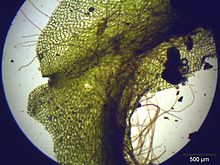Endive-like pool moss
| Endive-like pool moss | ||||||||||||
|---|---|---|---|---|---|---|---|---|---|---|---|---|

Endive-like basin moss ( Pellia endiviivolia ) |
||||||||||||
| Systematics | ||||||||||||
|
||||||||||||
| Scientific name | ||||||||||||
| Pellia endiviifolia | ||||||||||||
| ( Dicks. ) Dumort. |
The endive-like basin moss ( Pellia endiviifolia ), also called calyx basin moss , is a dioecious thallous liverwort.
Identifying features
The thin, transparent thalli of the endive-like pool moss are colored light green to dark green. They are forked, tongue-shaped to wedge-shaped, about 4 to 5 cm long and 2 to 9 mm wide. It grows in individual groups or in extensive lawns. The edges of the thallus are not infrequently wavy and curled. The characteristic, square to short rectangular thallus margin cells are about 40 to 70 µm long and 20 to 50 µm wide. The thallus tips have some mucous hairs on the underside, which consist of up to 8 cells. The tips can fall off in autumn and are used for vegetative reproduction. The cells inside are between 70 and 120 µm long and about 25 to 55 µm wide. Female plants are usually larger than the male. They form upright, up to 5 mm long Perichaetien, the kalyptra is short. Spore ripening occurs relatively rarely in spring.
Occurrence
The liverwort , which is typical for springy lime locations in deciduous forests, colonizes open, base and lime-rich to base-neutral, fresh to wet, shady to partially shaded, loamy, clay, stony-sandy, humus-poor soils at roadsides, excavations, clay pits, banks of water, rarely also in gardens or, more recently, in greenhouses. Frequent companion mosses are Dicranella varia , Barbula fallax or Bryum pseudotriquetrum . Its main area of distribution is in Europe.
literature
- Nebel, Philippi: Die Moose Baden-Württemberg Volume 3 (Ulmer Verlag, 1st edition, 2005 ISBN 3-8001-3278-8 )
- Jan-Peter Frahm , Wolfgang Frey , J. Döring: Moosflora 4th edition (UTB Verlag), ISBN 3-8252-1250-5
- Volkmar Wirth , Ruprecht Düll : Color Atlas of Lichen and Moss. Ulmer, Stuttgart 2000, ISBN 3-8001-3517-5 .

